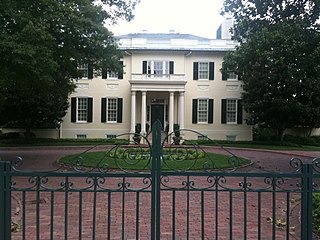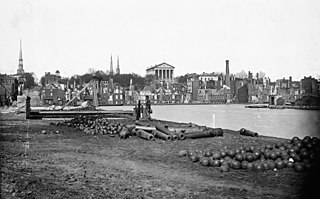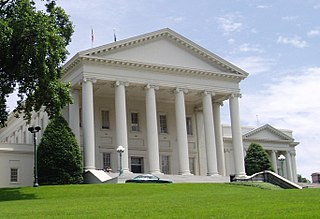
Felix Weihs de Weldon was an Austrian-born American sculptor. His most famous pieces include the United States Marine Corps War Memorial in Arlington County, Virginia and the Malaysian National Monument (1966) in Kuala Lumpur.

Monument Avenue is an avenue in Richmond, Virginia with a tree-lined grassy mall dividing the east- and westbound traffic, punctuated by statues memorializing Virginian Confederate veterans of the American Civil War, including Robert E. Lee, J.E.B. Stuart, Jefferson Davis, Thomas "Stonewall" Jackson, and Matthew Fontaine Maury. There is also a monument to Arthur Ashe, a Richmond native and international tennis star who was African-American. The first monument, a statue of Robert E. Lee, was erected in 1890. Between 1900 and 1925, Monument Avenue greatly expanded with architecturally significant houses, churches and apartment buildings.

The Seal of the Confederate States was used to authenticate certain documents issued by the federal government of the Confederate States. The phrase is used both for the physical seal itself, and more generally for the design impressed upon it. On May 20, 1863, C.S. Secretary of State Judah Benjamin instructed James Mason to arrange for its manufacture in London. The seal was first used publicly in 1864.

The American Civil War Museum is a multi-site museum in the Greater Richmond Region of central Virginia, dedicated to the history of the American Civil War. The museum operates three sites: The Museum and White House of the Confederacy and the American Civil War Center at Historic Tredegar in Richmond, and the Museum of the Confederacy–Appomattox. It maintains a comprehensive collection of artifacts, manuscripts, Confederate imprints, and photographs.

There are many outdoor sculptures in Washington, D.C. In addition to the capital's most famous monuments and memorials, many figures recognized as national heroes have been posthumously awarded with his or her own statue in a park or public square. Some figures appear on several statues: Abraham Lincoln, for example, has at least three likenesses, including those at the Lincoln Memorial, in Lincoln Park, and the old Superior Court of the District of Columbia. A number of international figures, such as Mohandas Gandhi, have also been immortalized with statues. The Statue of Freedom is a 19½-foot tall allegorical statue that rests atop the United States Capitol dome.

The Virginia Governor's Mansion, better known as the Executive Mansion, is located in Richmond, Virginia, on Capitol Square and serves as the official residence of the Governor of the Commonwealth of Virginia. Designed by Alexander Parris, it is the oldest occupied governor's mansion in the United States. It has served as the home of Virginia governors and their families since 1813. This mansion is both a Virginia and a National Historic Landmark, and has had a number of successive renovations and expansions during the 20th century.

The South Carolina State House is the building housing the government of the U.S. state of South Carolina, which includes the South Carolina General Assembly and the offices of the Governor and Lieutenant Governor of South Carolina. Located in the capital city of Columbia near the corner of Gervais and Assembly Streets, the building also housed the Supreme Court until 1971.

George Washington commanded the American Revolutionary War (1775–1783), and was the first President of the United States, from 1789 to 1797. In terms of personality, a leading biographer Douglas Southall Freeman concluded, "the great big thing stamped across that man is character." By character, says David Hackett Fischer "Freeman meant integrity, self-discipline, courage, absolute honesty, resolve, and decision, but also forbearance, decency, and respect for others." Because of his central role in the founding of the United States, Washington is often called the "Father of his Country". His devotion to republicanism and civic virtue made him an exemplary figure among early American politicians. His image has become an icon and is commonplace in American culture.

Richmond, Virginia, served as the capital of the Confederate States of America for almost the whole of the American Civil War. It was a vital source of weapons and supplies for the war effort, and the terminus of five railroads.

Jefferson Davis Memorial Historic Site is a 12.668-acre (51,270 m2) state historic site located in Irwin County, Georgia that marks the spot where Confederate States President Jefferson Davis was captured by United States Cavalry on Wednesday, May 10, 1865. The historic site features a granite monument with a bust of Jefferson Davis that is located at the place of capture. The memorial museum, built in 1939 by the Works Progress Administration, features Civil War era weapons, uniforms, artifacts and an exhibit about the president's 1865 flight from Richmond, Virginia to Irwin County, Georgia.

Major General George Henry Thomas, also known as the Thomas Circle Monument, is an equestrian sculpture in Washington, D.C. that honors Civil War general George Henry Thomas. The monument is located in the center of Thomas Circle, on the border of the downtown and Logan Circle neighborhoods. It was sculpted by John Quincy Adams Ward, best known for his work on the George Washington statue. Attendees at the dedication in 1879 included President Rutherford B. Hayes, Generals Irvin McDowell, Philip Sheridan, and William Tecumseh Sherman, senators and thousands of soldiers.

Brevet Lt. General Winfield Scott is an equestrian statue in Washington, D.C., that honors career military officer Winfield Scott. The monument stands in the center of Scott Circle, a traffic circle and small park at the convergence of 16th Street, Massachusetts Avenue and Rhode Island Avenue NW. The statue was sculpted by Henry Kirke Brown, whose best-known works include statues of George Washington in New York and Nathanael Greene in Washington, D.C. It was the first of many sculptures honoring Civil War generals that were installed in Washington, D.C.'s traffic circles and squares and was the second statue in the city to honor Scott.

The Robert Edward Lee is an outdoor bronze equestrian statue of Robert E. Lee and his horse Traveller. Commissioned in 1917 and dedicated in 1924, it is located in Charlottesville, Virginia's Market Street Park in the Charlottesville and Albemarle County Courthouse Historic District. It was listed on the National Register of Historic Places in 1997.

The Robert E. Lee Monument was the first and is the largest of Monument Avenue's monuments in Richmond, Virginia. In 1876 the Lee Monument Association commissioned the adaption of a painting done by artist Adalbert Volck into a lithograph. The lithograph, depicting Robert E. Lee on his horse, was the basis for the bronze statue created by French sculptor Antonin Mercié. It was noted in the National Register of Historic Places that "the horse is not a representation of Lee’s famous mount Traveller. The sculptor did not find the size of the actual horse to be in keeping with the overall composition and therefore created an ideal mount with the necessary requirements." The cornerstone was placed on October 27, 1887. The statue was cast in several pieces separately and then the assembled statue was displayed in Paris before it was shipped to Richmond, where it arrived by rail on May 4. Newspaper accounts indicate that 10,000 people helped pull four wagons with the pieces of the monument. The completed statue was unveiled on May 29, 1890. The statue serves as a traffic circle at the intersection of Monument Avenue and Allen Avenue. Lee stands 14 feet (4.3 m) high atop his horse and the entire statue is 60 feet (18 m) tall standing on a stone base.

























